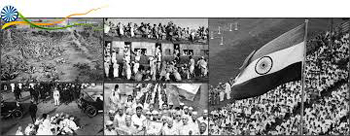National Movement in India- Partition & Independence 1939-1947
Sakshi Education
 Key points:
Key points: - The British announced that India would be participating in the world war-II On behalf of the allied powers without any consent of Indian Congress leaders.
- The British actively raised doubts about the right of the Congress to represent the people of the country. They followed ‘the Divide and Rule policy’ vigorously. The British supported and encouraged the plans of the Muslim league.
- Hindu Mahasabha, RSS gave out the message that India was the land of the Hindus who were in a majority. Congress argued that Hindus and Muslims were not people of two different nations, but part and parcel of one Indian nation.
- On 23rd March 1940, the Muslim League moved a resolution demanding a measure of autonomy for the Muslim majority areas of the Subcontinent.
- As the Cripps Mission was failed in 1942, Gandhiji decided to take-up another mass movement called “Quit India”.
- Subhash Chandra Bose recruited prisoners of war from Japan in his army which he called “Indian National Army (INA)”
- Discussions about the transfer of power broke down due to Jinnah’s unrelenting demand that League should have an absolute right to choose all the Muslim members of the executive council.
- In March 1946, the British Cabinet sent a three member mission to Delhi to examine the League’s demand. Muslim League called for “Direct Action” for winning its Pakistan demand.
- In February, 1947 Wavell was replaced as viceroy by Lord Mountbatten. He announced that British India would be freed but also divided. On 15th August 1947 India got independence.
- All states except Kashmir, Hyderabad and Junagadh had agreed to sign the Instrument of Accession with India by 1947.
- Dominion status: It means an autonomous polities that were nominally under the British sovereignty. Constituting the British Empire and British Commonwealth, beginning in the later of the 19th century.
- Divide and Rule: The policy maintaining control over colonies or sub-ordinates by encouraging dissent between them, thereby preventing them from uniting in opposition the British followed the “Divide and Rule” policy in India.
- Separate Electorate: The type of election in which minorities, scheduled castes, backward castes and women select their own representatives separately. This means election for specific groups of the population. These are called Separate Electorates.
1. Make a list of various reasons for the partition of the country?
- The British were desperate with the Indian people revolting against their rule. They looked for ways to punish the Congress and weaken its hold over the people. They followed the “Divide and Rule Policy”. As a result, the British government supported and encouraged the plans of the Muslim League.
- The League could create the impression that the Congress was basically a Hindu Party and did not want to share power with the Muslims.
- Muslim League demanded a separate electorate. This idea of separateness of Muslims was built into the electoral process of India.
- The Muslim League pledged its full support for the British during the World War-II.
- Activities of Muslim League, Congress’ policy of appeasement to communal reaction and provisions of the Indian Independent Act are some reasons for the partition of the country.
- Peasants were organised by the Communist Party of India to share power of the landlords and zamindars by taking up agitations like armed struggles in Telangana region.
- Among the working communities, trade unions like AITUC organized strikes, agitations for the better wages and other allowances for the workers.
- For the women, number of women associations were formed to share power as well as for the equality like All India Women’s Conference, National Federation of Indian Women.
- The Hindu Maha Sabha and the Rashtriya Swayamsewak Sangh (RSS) were engaged in active mobilisation of Hindus. They also gave out the message that India was the land of Hindus who were in a majority.
- The Muslim League was a party formed in 1906. The British government supported and encouraged the plans of the Muslims League and downplayed the importance of the Congress.
- League demanded for separate electorates for Muslims. The league could create the impression that the congress was basically a Hindu party and did not want to share power with the Muslims.
- The British were desperate with the Indian people revolting against their rule. They looked for ways to punish the Congress and weaken its hold over the people. The British actively raised doubts about the right of the Congress to represent the people of the country. They followed the divide and rule policy in India to implement their schemes.
- The British government supported the plans of the Muslim League and downplayed the importance of the Congress. It gave scope for the Muslim League and its leaders like MA Jinnah become more active in mass politics.
- To solve the problems of minorities, the British imperialists implementing their policy of divide and rule, separated the united India MA Jinnah became more active in mass politics.
- The British however, did not relent in their aim to keep two communities at odds with each other. The colonial masters feared the prospect of an emerging Indian nationalism that might lead to ouster of the British rule in India.
- The same policy i.e. ‘Divide and Rule’ adopted by the British in India is quite similar to that of the policy by it is Nigeria.
- Hindu Maha Sabha and RSS which were established in 1922 and 1925 respectively formed to spread Hinduism is the country involved in congress politics and influence congress to take decisions against Muslim community.
- In 1906, the Muslim League was formed to safeguard the interest of the Muslim community in India. The league involved in politics and achieved the separate electorates for the Muslims.
- On 23 March 1940, the League moved a resolution demanding a measure of autonomy for the Muslim majority areas of the Subcontinent.
- From 1940 to 1946, the League was able to convince Muslim masses of the benefits and need for a separate nation. They professed that in a spate state, there would be greater religious freedom for Muslims and the leaders can run the government the way they wanted.
- Gandhiji had been preaching brotherhood among the different religious groups. Nehru was a strong supporter of secularism. Their efforts could not divorce religion from politics. Rather the vested interests of the politicians started exploiting caste and religion for gaining of political advantage.
- Workers were angry about low wages. In 1946, the guards of the Royal Indian Navy in Bombay harbor came out on hunger strike to protest against bad food and behavior of the British officers. The worker and peasants were mobilised during the last years of freedom struggle by the Communist Party of India and its affiliated trade union –All India Trade Union Congress.
- The year 1946 was a year of strikes and work stoppages in factories and mills in many parts of the country. CPI and the socialist parties were active in these movements.
- An agitation was started in Bengal by small and poor peasants who took land of the bigger land owners to cultivate. This was called the ‘Tebhaga Movement’ and was led by the provincial Kisan Sabha.
- In Hyderabad, the Communist Party led a massive movement of farmers of Telangana region. The peasants took up arms to resist the rulers and their armies. Almost 3000 villages were part of the movement.
- Another armed revolt of presents took place in Travancore state in Punnapra-Vayalar region. The Telangana armed struggle, Tebhaga Movement and Punnapra-Vayalar had a great revolutionary impact in the country.
- The ordinary people affected hard at the time of partition of India.
- Nearly 15 million people of both Hindu and Muslim communities were displaced and became refugees. More than a million lost their lives.
- Two to five lakh people, both Muslim and Hindu religions were killed.
- They became refugees, lived in relief camps, and moved out on trains to find new homes.
- Gandhiji moved amongst riot hit people, in campus and hospitals, spreading the message of peace and brotherhood. At the initiative of Gandhiji and Nehru, the congress passed a resolution on “The rights of minorities”.
- It resolution stated that “India is a land of many religions and many races, and must remain so”. India would be a “democratic secular state” where all citizens enjoy full rights and are equally entitled to the protection of the state, irrespective of the religion to which they belong.
SHORT ANSWER QUESTIONS
1. Make a table and show how different groups and individuals in India responded to World War-II? What dilemmas were faced by these groups?
1. Make a table and show how different groups and individuals in India responded to World War-II? What dilemmas were faced by these groups?
Name of the GroupMode of Response
Peasants
They did not want wars.
Industrial workers
They opposed World War-II due to high prices and lockouts of the factories.
Women
They did not want wars.
Educated scholars
They wanted war to suppress fascism and Nazism.
Leaders of the Congress
They wanted war with Axis powers
The Muslim league
Supported the British war effort, was allowed to function and gained strength
- The Congress leaders were opposed to the ideology of Fascism. The Congress expected that the British would see their double standard is the expectation that India should support them in fighting Fascists but not giving full freedom to India.
- By the time of India’s independence, there were around 550 princely states in Indian territory.
- All these princely states were asked to decide if they wanted to join India, Pakistan or remain independent.
- Sardar Vallabbhai Patel was given charge of the matter of merging princely states into Indian union in July 1947.
- Except Kashmir, Hyderabad and Junagadh, all were agreed to sign the Instrument of Accession with India.
- These reaming three states were also made to join in the next two years.
Published date : 17 Dec 2014 02:17PM

















